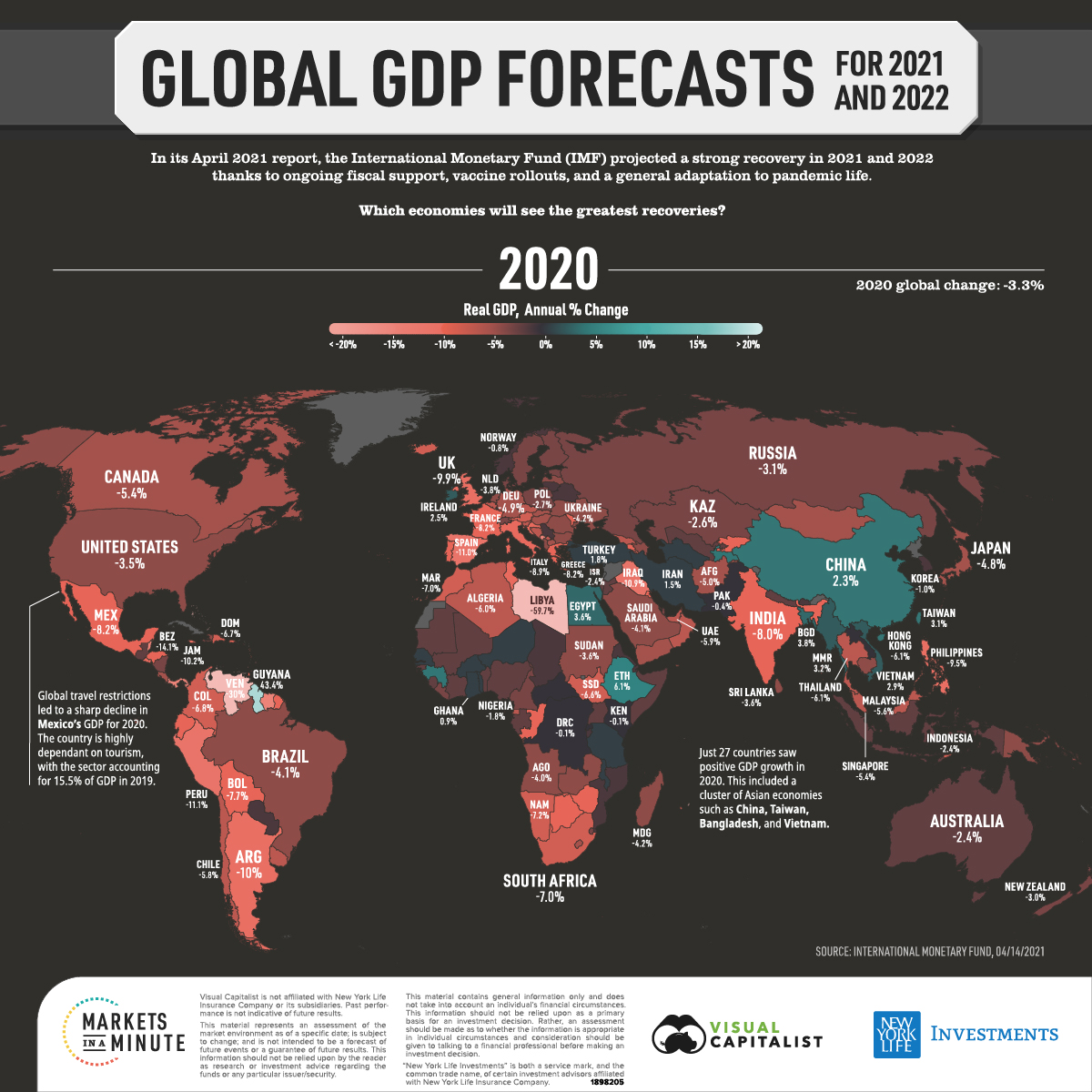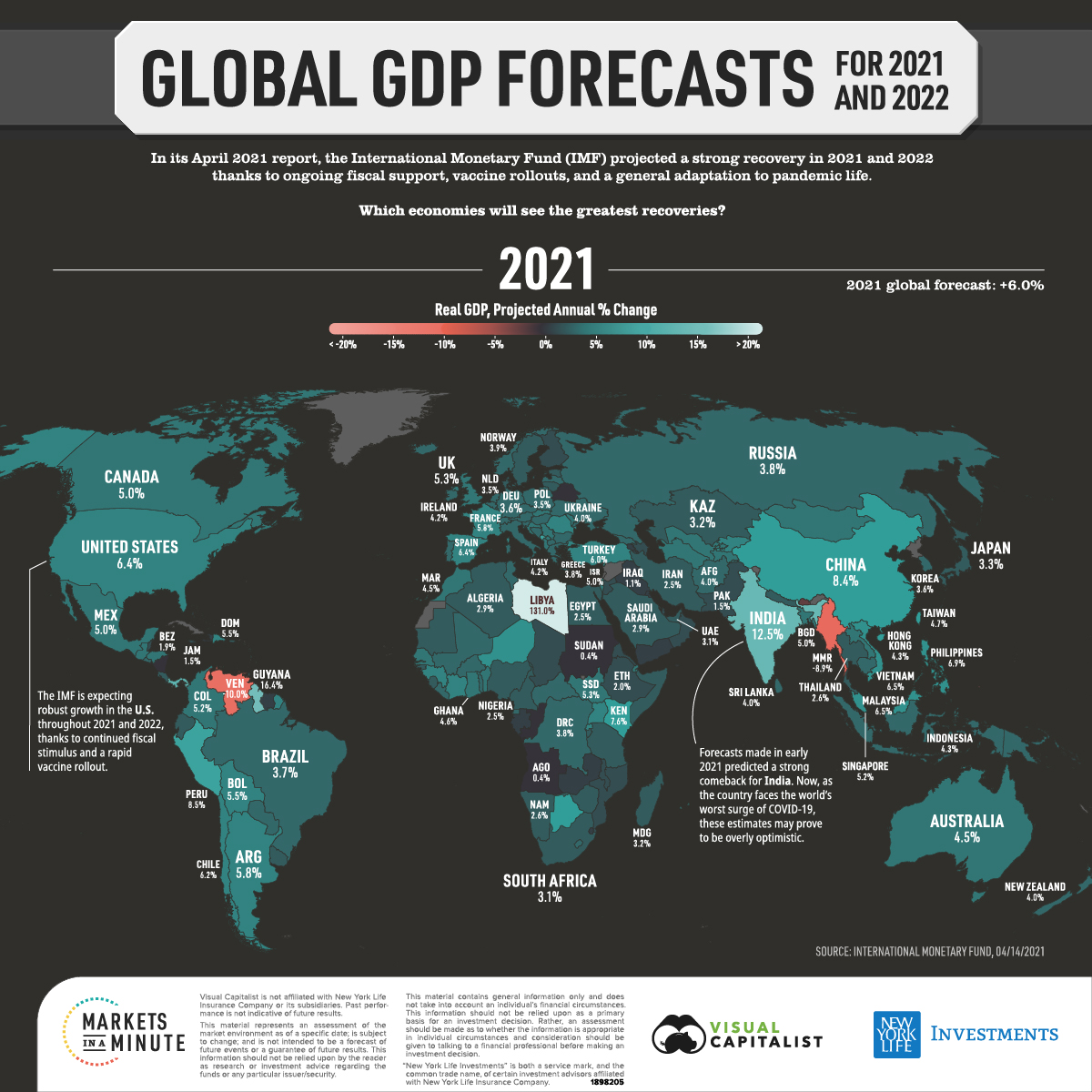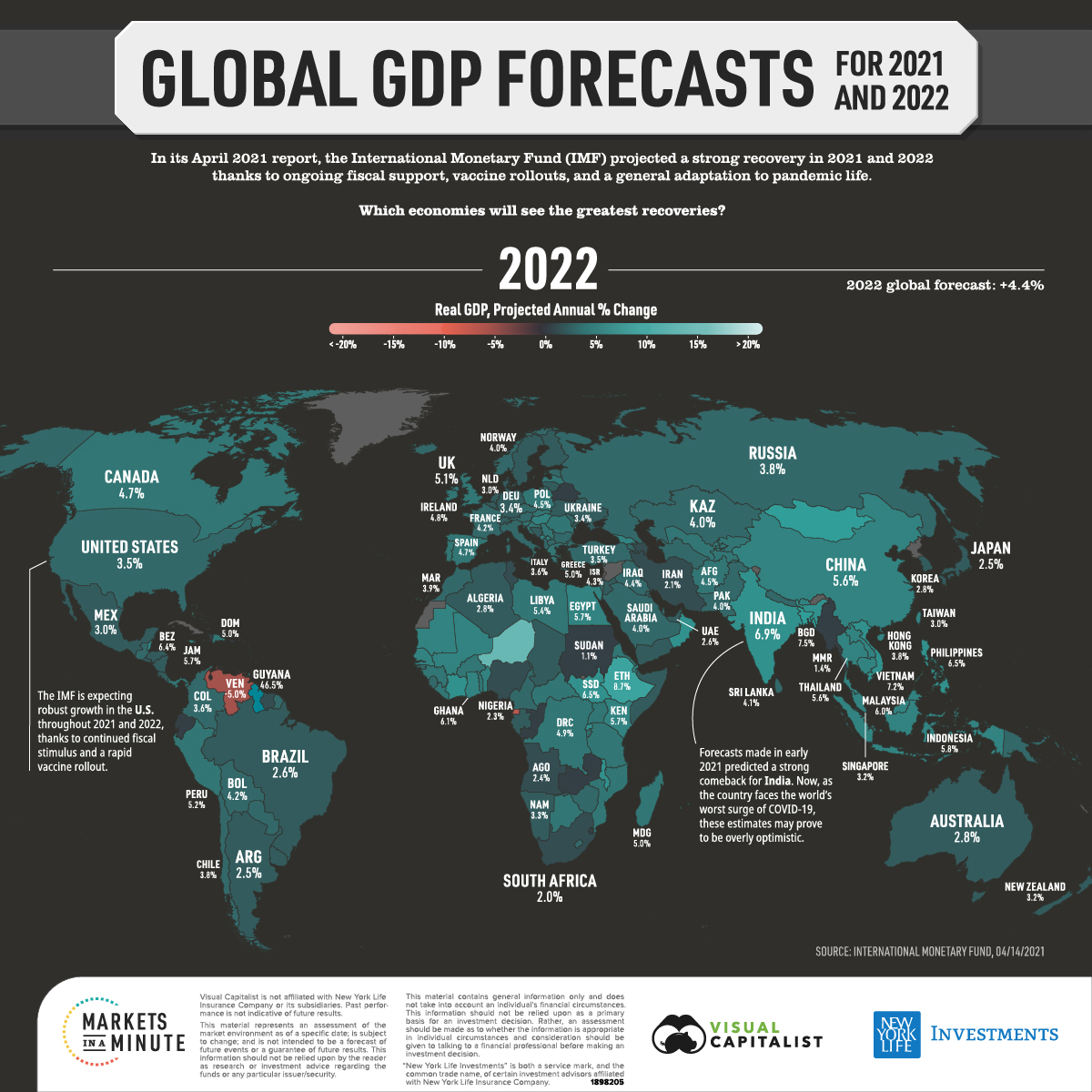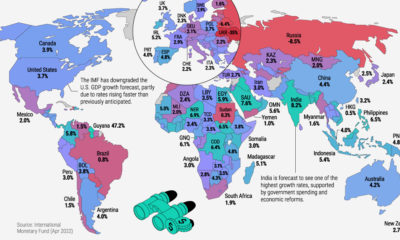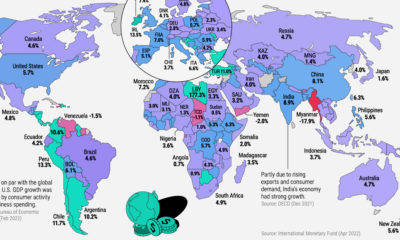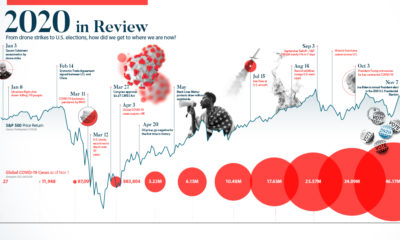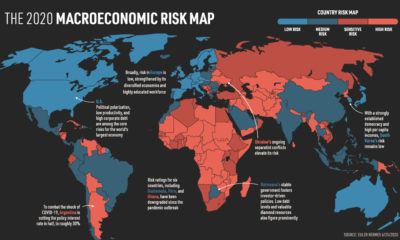This infographic is available as a poster.
Mapped: Global GDP Forecasts for 2021 and Beyond
In the April 2021 version of its Global Economic Outlook, the International Monetary Fund (IMF) reiterated its expectations of a strong economic recovery over the next few years.
Economists acknowledged that, while the path of the pandemic remains uncertain, global vaccine rollouts represent the light at the end of the tunnel. As a result, global GDP growth forecasts for 2021 and 2022 sit at +6.0% and +4.4% respectively.
In this Markets in a Minute chart from New York Life Investments, we’ve mapped the IMF’s country-level GDP forecasts to see which areas are expected to have the greatest rebounds.
Country-level Data
The following table lists each country’s percentage GDP change for 2020, as well as forecasts for 2021 and 2022.
| Jurisdiction | 2020 GDP Growth (%) | 2021 GDP Growth Forecasts (%) | 2022 GDP Growth Forecasts (%) |
| Afghanistan | -5.0 | 4.0 | 4.5 |
| Albania | -3.5 | 5.0 | 4.0 |
| Algeria | -6.0 | 2.9 | 2.8 |
| Angola | -4.0 | 0.4 | 2.4 |
| Antigua and Barbuda | -17.3 | -3.0 | 11.9 |
| Argentina | -10.0 | 5.8 | 2.5 |
| Armenia | -7.6 | 1.0 | 3.5 |
| Aruba | -25.5 | 5.0 | 12.0 |
| Australia | -2.4 | 4.5 | 2.8 |
| Austria | -6.6 | 3.5 | 4.0 |
| Azerbaijan | -4.3 | 2.3 | 1.7 |
| Bahrain | -5.4 | 3.3 | 3.1 |
| Bangladesh | 3.8 | 5.0 | 7.5 |
| Barbados | -17.6 | 4.1 | 7.7 |
| Belarus | -0.9 | -0.4 | 0.8 |
| Belgium | -6.4 | 4.0 | 3.1 |
| Belize | -14.1 | 1.9 | 6.4 |
| Benin | 2.0 | 5.0 | 6.0 |
| Bhutan | -0.8 | -1.9 | 5.7 |
| Bolivia | -7.7 | 5.5 | 4.2 |
| Bosnia and Herzegovina | -5.5 | 3.5 | 3.3 |
| Botswana | -8.3 | 7.5 | 5.4 |
| Brazil | -4.1 | 3.7 | 2.6 |
| Brunei Darussalam | 1.2 | 1.6 | 2.5 |
| Bulgaria | -3.8 | 4.4 | 4.4 |
| Burkina Faso | 0.8 | 4.3 | 5.2 |
| Burundi | -1.3 | 2.8 | 3.7 |
| Cabo Verde | -14 | 5.8 | 6.0 |
| Cambodia | -3.5 | 4.2 | 6.0 |
| Cameroon | -2.8 | 3.4 | 4.3 |
| Canada | -5.4 | 5.0 | 4.7 |
| Central African Republic | 0 | 3.5 | 5.0 |
| Chad | -0.9 | 1.8 | 2.6 |
| Chile | -5.8 | 6.2 | 3.8 |
| China | 2.3 | 8.4 | 5.6 |
| Colombia | -6.8 | 5.2 | 3.6 |
| Comoros | -0.5 | 0 | 3.6 |
| Costa Rica | -4.8 | 2.6 | 3.3 |
| Côte d'Ivoire | 2.3 | 6.0 | 6.5 |
| Croatia | -9.0 | 4.7 | 5.0 |
| Cyprus | -5.1 | 3.0 | 3.9 |
| Czech Republic | -5.6 | 4.2 | 4.3 |
| Democratic Republic of the Congo | -0.1 | 3.8 | 4.9 |
| Denmark | -3.3 | 2.8 | 2.9 |
| Djibouti | -1.0 | 5.0 | 5.5 |
| Dominica | -10.4 | -0.4 | 5.8 |
| Dominican Republic | -6.7 | 5.5 | 5.0 |
| Ecuador | -7.5 | 2.5 | 1.3 |
| Egypt | 3.6 | 2.5 | 5.7 |
| El Salvador | -8.6 | 4.2 | 2.8 |
| Equatorial Guinea | -5.8 | 4.0 | -5.9 |
| Eritrea | -0.6 | 2.0 | 4.9 |
| Estonia | -2.9 | 3.4 | 4.2 |
| Eswatini | -3.3 | 1.4 | 0.9 |
| Ethiopia | 6.1 | 2.0 | 8.7 |
| Fiji | -19.0 | 5.0 | 9.0 |
| Finland | -2.9 | 2.3 | 2.5 |
| France | -8.2 | 5.8 | 4.2 |
| Gabon | -1.8 | 1.2 | 2.7 |
| Georgia | -6.1 | 3.5 | 5.8 |
| Germany | -4.9 | 3.6 | 3.4 |
| Ghana | 0.9 | 4.6 | 6.1 |
| Greece | -8.2 | 3.8 | 5.0 |
| Grenada | -13.5 | -1.5 | 5.2 |
| Guatemala | -1.5 | 4.5 | 4.0 |
| Guinea | 5.2 | 5.6 | 5.2 |
| Guinea-Bissau | -2.4 | 3.0 | 4.0 |
| Guyana | 43.4 | 16.4 | 46.5 |
| Haiti | -3.7 | 1.0 | 1.0 |
| Honduras | -8.0 | 4.5 | 3.3 |
| Hong Kong SAR | -6.1 | 4.3 | 3.8 |
| Hungary | -5.0 | 4.3 | 5.9 |
| Iceland | -6.6 | 3.7 | 3.6 |
| India | -8.0 | 12.5 | 6.9 |
| Indonesia | -2.1 | 4.3 | 5.8 |
| Iraq | -10.9 | 1.1 | 4.4 |
| Ireland | 2.5 | 4.2 | 4.8 |
| Islamic Republic of Iran | 1.5 | 2.5 | 2.1 |
| Israel | -2.4 | 5.0 | 4.3 |
| Italy | -8.9 | 4.2 | 3.6 |
| Jamaica | -10.2 | 1.5 | 5.7 |
| Japan | -4.8 | 3.3 | 2.5 |
| Jordan | -2.0 | 2.0 | 2.7 |
| Kazakhstan | -2.6 | 3.2 | 4.0 |
| Kenya | -0.1 | 7.6 | 5.7 |
| Kiribati | -0.5 | 1.8 | 2.5 |
| Korea | -1.0 | 3.6 | 2.8 |
| Kosovo | -6.0 | 4.5 | 5.5 |
| Kuwait | -8.1 | 0.7 | 3.2 |
| Kyrgyz Republic | -8.0 | 6.0 | 4.6 |
| Lao P.D.R. | -0.4 | 4.6 | 5.6 |
| Latvia | -3.6 | 3.9 | 5.2 |
| Lebanon | -25 | n/a | n/a |
| Lesotho | -4.5 | 3.5 | 4.3 |
| Liberia | -3.0 | 3.6 | 4.7 |
| Libya | -59.7 | 131 | 5.4 |
| Lithuania | -0.8 | 3.2 | 3.2 |
| Luxembourg | -1.3 | 4.1 | 3.6 |
| Macao SAR | -56.3 | 61.2 | 43.0 |
| Madagascar | -4.2 | 3.2 | 5.0 |
| Malawi | 0.6 | 2.2 | 6.5 |
| Malaysia | -5.6 | 6.5 | 6.0 |
| Maldives | -32.2 | 18.9 | 13.4 |
| Mali | -2.0 | 4.0 | 6.0 |
| Malta | -7.0 | 4.7 | 5.6 |
| Marshall Islands | -3.3 | -1.5 | 3.5 |
| Mauritania | -2.2 | 3.1 | 5.6 |
| Mauritius | -15.8 | 6.6 | 5.2 |
| Mexico | -8.2 | 5.0 | 3.0 |
| Micronesia | -1.6 | -3.7 | 2.8 |
| Moldova | -7.5 | 4.5 | 4.0 |
| Mongolia | -5.3 | 5.0 | 7.5 |
| Montenegro | -15.2 | 9.0 | 5.5 |
| Morocco | -7.0 | 4.5 | 3.9 |
| Mozambique | -0.5 | 2.1 | 4.7 |
| Myanmar | 3.2 | -8.9 | 1.4 |
| Namibia | -7.2 | 2.6 | 3.3 |
| Nauru | 0.7 | 1.6 | 0.9 |
| Nepal | -1.9 | 2.9 | 4.2 |
| Netherlands | -3.8 | 3.5 | 3.0 |
| New Zealand | -3.0 | 4.0 | 3.2 |
| Nicaragua | -3.0 | 0.2 | 2.7 |
| Niger | 1.2 | 6.9 | 12.8 |
| Nigeria | -1.8 | 2.5 | 2.3 |
| North Macedonia | -4.5 | 3.8 | 4.0 |
| Norway | -0.8 | 3.9 | 4.0 |
| Oman | -6.4 | 1.8 | 7.4 |
| Pakistan | -0.4 | 1.5 | 4.0 |
| Palau | -10.3 | -10.8 | 10.4 |
| Panama | -17.9 | 12.0 | 5.0 |
| Papua New Guinea | -3.9 | 3.5 | 4.2 |
| Paraguay | -0.9 | 4.0 | 4.0 |
| Peru | -11.1 | 8.5 | 5.2 |
| Philippines | -9.5 | 6.9 | 6.5 |
| Poland | -2.7 | 3.5 | 4.5 |
| Portugal | -7.6 | 3.9 | 4.8 |
| Puerto Rico | -7.5 | 2.5 | 0.7 |
| Qatar | -2.6 | 2.4 | 3.6 |
| Republic of Congo | -7.8 | 0.2 | 1.0 |
| Romania | -3.9 | 6.0 | 4.8 |
| Russia | -3.1 | 3.8 | 3.8 |
| Rwanda | -0.2 | 5.7 | 6.8 |
| Samoa | -3.2 | -7.8 | 1.7 |
| San Marino | -9.7 | 4.5 | 3.4 |
| São Tomé and Príncipe | -6.5 | 3.0 | 5.0 |
| Saudi Arabia | -4.1 | 2.9 | 4.0 |
| Senegal | 0.8 | 5.2 | 6.0 |
| Serbia | -1.0 | 5.0 | 4.5 |
| Seychelles | -13.4 | 1.8 | 4.3 |
| Sierra Leone | -2.2 | 3.0 | 3.6 |
| Singapore | -5.4 | 5.2 | 3.2 |
| Slovak Republic | -5.2 | 4.7 | 4.5 |
| Slovenia | -5.5 | 3.7 | 4.5 |
| Solomon Islands | -4.3 | 1.5 | 4.5 |
| Somalia | -1.5 | 2.9 | 3.2 |
| South Africa | -7 | 3.1 | 2.0 |
| South Sudan | -6.6 | 5.3 | 6.5 |
| Spain | -11.0 | 6.4 | 4.7 |
| Sri Lanka | -3.6 | 4.0 | 4.1 |
| St. Kitts and Nevis | -18.7 | -2.0 | 10.0 |
| St. Lucia | -18.9 | 3.1 | 10.7 |
| St. Vincent and the Grenadines | -4.2 | -0.1 | 4.9 |
| Sudan | -3.6 | 0.4 | 1.1 |
| Suriname | -13.5 | 0.7 | 1.5 |
| Sweden | -2.8 | 3.1 | 3.0 |
| Switzerland | -3.0 | 3.5 | 2.8 |
| Syria | n/a | n/a | n/a |
| Taiwan Province of China | 3.1 | 4.7 | 3.0 |
| Tajikistan | 4.5 | 5.0 | 4.5 |
| Tanzania | 1.0 | 2.7 | 4.6 |
| Thailand | -6.1 | 2.6 | 5.6 |
| The Bahamas | -16.3 | 2.0 | 8.5 |
| The Gambia | 0 | 6.0 | 6.5 |
| Timor-Leste | -6.8 | 2.8 | 4.9 |
| Togo | 0.7 | 3.5 | 4.5 |
| Tonga | -0.5 | -2.5 | 2.5 |
| Trinidad and Tobago | -7.8 | 2.1 | 4.1 |
| Tunisia | -8.8 | 3.8 | 2.4 |
| Turkey | 1.8 | 6.0 | 3.5 |
| Turkmenistan | 0.8 | 4.6 | 3.9 |
| Tuvalu | 0.5 | 2.5 | 3.5 |
| Uganda | -2.1 | 6.3 | 5.0 |
| Ukraine | -4.2 | 4.0 | 3.4 |
| United Arab Emirates | -5.9 | 3.1 | 2.6 |
| United Kingdom | -9.9 | 5.3 | 5.1 |
| United States | -3.5 | 6.4 | 3.5 |
| Uruguay | -5.7 | 3.0 | 3.1 |
| Uzbekistan | 1.6 | 5.0 | 5.3 |
| Vanuatu | -9.2 | 3.2 | 4.6 |
| Venezuela | -30.0 | -10.0 | -5.0 |
| Vietnam | 2.9 | 6.5 | 7.2 |
| West Bank and Gaza | -11.0 | 5.7 | 7.0 |
| Yemen | -5.0 | 0.5 | 2.5 |
| Zambia | -3.5 | 0.6 | 1.1 |
| Zimbabwe | -8.0 | 3.1 | 4.0 |
Just 27 countries saw positive GDP growth in 2020, including a cluster of Asian economies that includes China, Taiwan, and Vietnam. Although the virus originated in China, the country’s strict lockdowns enabled it to flatten the infection curve relatively quick. As a result, Asia’s biggest economy returned to pre-COVID GDP levels in 2020—something most others aren’t expected to do until 2023.
Forecasts for 2021 are very positive, with the vast majority of countries expected to bounce back economically. Within advanced economies, the U.S. is expected to be a strong performer. The IMF believes that the Biden administration’s new fiscal package, valued at $1.9 trillion, will provide a strong boost to growth.
Looking further to 2022, the IMF expects GDP growth to remain positive around the world. Many European economies will experience positive GDP growth above 3%, including France (+4.2%), Germany (+3.4%), and Spain (+4.7%). The European Central Bank (ECB) has relied on expansionary monetary policy to stimulate its economy during the pandemic, growing its balance sheet by over $2 trillion since February 2020.
Uncertainty Remains, Despite Vaccine Rollouts
Given the unpredictable nature of COVID-19 and its many variants, the GDP forecasts visualized in the above maps should not be interpreted as concrete figures.
India, which was forecasted to grow its GDP by 12.5% in 2021, is now facing the world’s worst surge of COVID-19, fueled in part by the emerging B1617 variant that many are dubbing a “double mutation”.
“We completely let down our guard and assumed in January that the pandemic was over.”
– K. Srinath Reddy, President, Public Health Foundation of India
It remains to be seen if India’s second outbreak will significantly impact its economy, or even the economies of other countries. This situation does, however, serve as a reminder that the virus can still surprise us.

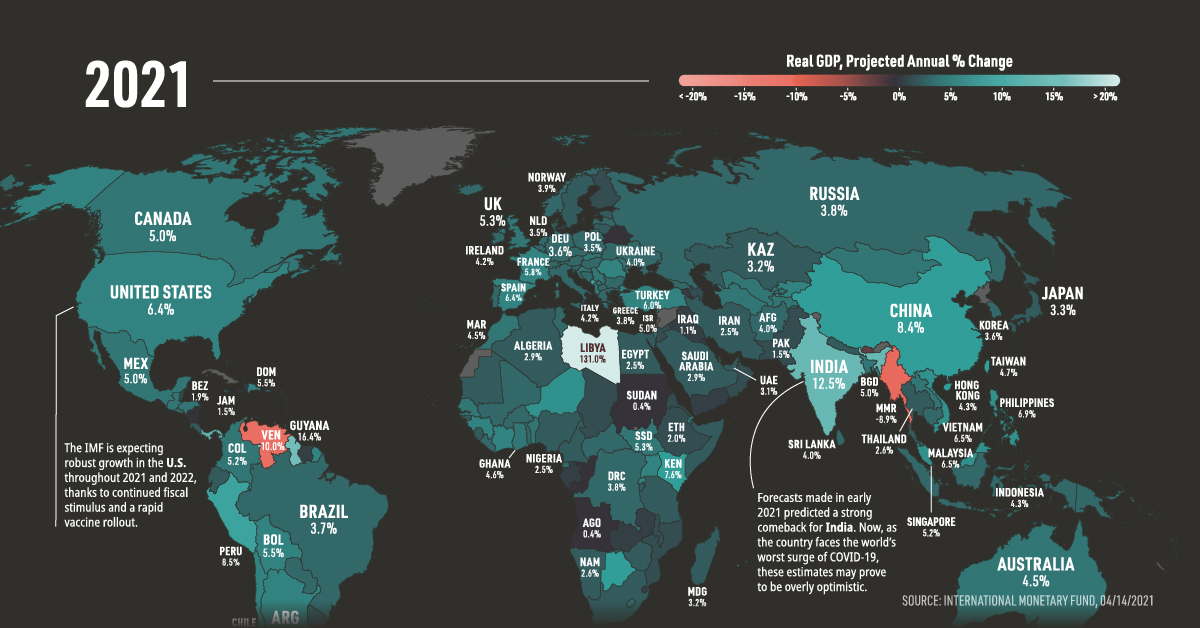

 Infographics2 years ago
Infographics2 years ago
 Markets in a Minute2 years ago
Markets in a Minute2 years ago
 Markets in a Minute2 years ago
Markets in a Minute2 years ago
 Infographics2 years ago
Infographics2 years ago
 Markets in a Minute1 year ago
Markets in a Minute1 year ago
 Markets in a Minute2 years ago
Markets in a Minute2 years ago
 Infographics1 year ago
Infographics1 year ago
 Markets in a Minute2 years ago
Markets in a Minute2 years ago